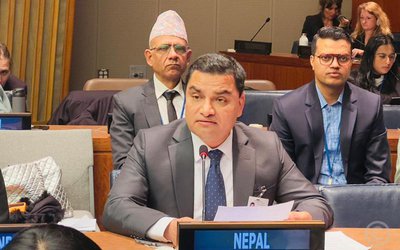
When Nepali patients have angina ( heart pain) or suffer from a heart attack, life-saving treatment available in Nepal now includes angioplasty. For sure angioplasty is expensive, but because this procedure is so commonly done here in both government and private hospitals, it may be important to know what angioplasty involves. Angina and heart attacks are usually caused by blockage (which usually consists of an atherosclerotic plaque) in the heart arteries. By using a dye and taking a special picture of the heart and its arteries (a cardiac angiogram) the location and extent of the blockage (plaque) in the coronary arteries is determined.
Then, during the angioplasty the heart doctor (cardiologist) basically performs a plumbing procedure. The cardiologist uses a deflated balloon at the end of a thin tube ( catheter) which is threaded into a peripheral blood vessel and made to reach the coronary artery where the blockage is located. The balloon is inflated at the site of the blockage which compresses the plaque against the wall ( pic), and sure enough, restores circulation of blood into the artery and blood flow into the all -important heart muscles. Without proper supply of blood the heart muscles cannot perform their vital role of pumping blood to the different parts of the body.
The balloon is then deflated and withdrawn together with the catheter. However in the beginning when this procedure was first started, the artery over a short period of time narrowed down without a “scaffolding” in place. Hence the concept of stents, which are basically scaffolds, emerged.
These stents introduced into the same catheter through which the balloon was threaded were at first bare-metal stents ( BMS). But these bare metals caused a tissue reaction inside the heart artery and re blocked the artery. To avoid these problem, entrepreneurs made drug-eluting stent ( DES). Basically the same metal stents were now coated with drugs which inhibit the tissue reaction the BMS elicited. But, you guessed it, the DES is much more expensive than BMS, but because complications may be significantly less with DES, in the long run the DES may prove to be a better investment. DES placement in angioplasty procedures is now a standard treatment option all over the world where people can afford this.
Cardiac surgeons still perform the more invasive coronary artery bypass graft (CABG) surgery by taking a graft from a peripheral blood vessel and bypassing the diseased segment in the heart arteries. But the less invasive angioplasty with stent placement is the preferred option wherever possible.

Buddha Basnyat MD
Buddha Basnyat, MD, MSc, FACP, FRCP, Director of the Oxford University Clinical Research Unit-Patan Academy of Health Sciences, Kathmandu.
- Altitude Sickness
- Feb 20, 2018
- Post-earthquake Nepal: The Way Forward
- Dec 13, 2015
- The Annapurna Sanctuary
- Nov 29, 2015
- Diarrhea at the Summit
- Nov 08, 2015
- Altitude Sickness ( AMS, HAPE, HACE)
- Oct 15, 2015















